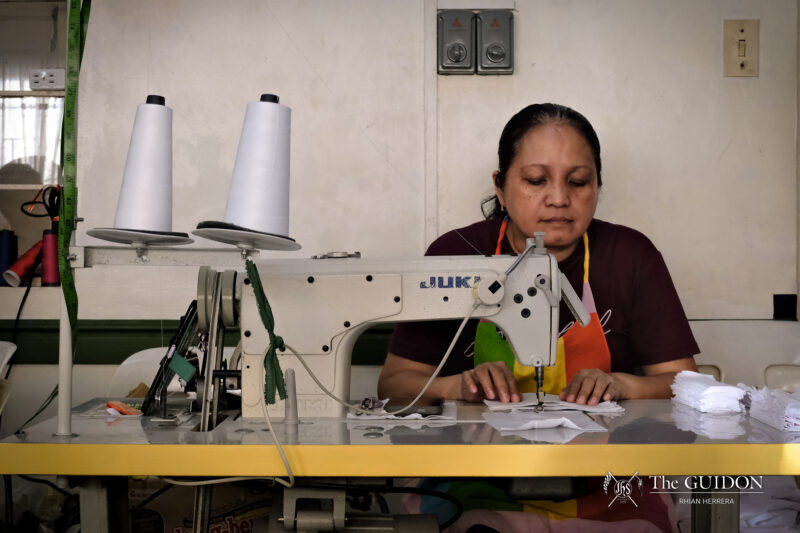To make sense of the world, people oftentimes turn to story-telling. Some can tell truths through news reports, literature, and song lyrics, but what happens when words seem to fail? This is when we turn to the visual arts; an admission that some stories cannot be done justice within the confines of language.
Basilio Sepe—a freelance photojournalist based in Manila who covers national and regional concerns—says that there is art in telling stories through images. In an attempt to contribute to expanding the national awareness on crises through visual consciousness, Sepe shares three of his photos and the narratives behind each one.
Masking victims, killing stories: War on drugs
Photos Courtesy of Basilio Sepe
“[This picture] was one of the scariest moments I’ve seen while documenting the drug war because that was the first time I saw a person,” Sepe says. “His head was wrapped in tape and the policemen or [Scene of the Crime Operatives] were removing the tape carefully.”
Sepe shares that he started documenting extrajudicial killings as early as college; his first encounter with the phenomenon was the death of Michael Siaron, whose photographs would later be well known because of its similarity with Michaelangelo’s famous sculpture Pieta. “From that moment on, I decided to keep on shooting and keep on documenting [extrajudicial killings],” Sepe says.
Going back to the photo, Sepe mentions that it was actually not his first subject of the night. Upon arriving at the scene, he and other photojournalists were directed to one body only to coincidentally find another victim hidden from view—the victim captured in his photo.
Despite weariness from the nightly coverages and gruesome scenes, he persisted for the sake of being able to cover what many have turned their heads away from. “Nag-lie low na yung issue ngayon, hindi na masyadong nakukunan (The issue has died down, no one is taking photos of it anymore),” he laments. He shares how he watched the convoy of photojournalists diminish slowly in numbers with the remaining cameramen earning the title of “nightcrawlers.”
With a death toll of over thousands of people and less coverage than when it first started, the nationwide War on Drugs remains immortalized in the photos of journalists like Sepe who braved the phenomenon nightly.
Among the ashes: Taal volcano eruption
This picture Sepe took on Volcano Island, in the middle of Taal Lake, reveals that what was once a picturesque landscape of trees and foliage is now a desert of ash. The foreboding plume of smoke from the crater reminds Sepe of how close he was to danger: “Nakakatakot syempre. If something happens, wala na kami. Kasi kapag sumabog iyan, di kami makakaalis kaagad (Of course, it was scary. If something happens, we’re gone. If it erupts, we can’t leave immediately).”
It was initially a surge of passion that led Sepe to document the Taal Volcano eruption last January. “Inaasikaso ko yung [Bureau of Internal Revenue documents] ko nung time na iyon. So hanggang sa nakita ko yung tweet…[I thought] ‘Uy malaki to, kailangan ready ako to go there’ (I was handling my [Bureau of Internal Revenue] documents at that time, until I saw a tweet…[I thought] ‘This is big, I need to be ready to go there’),” Sepe recounts.
Determined to capture the eruption’s aftermath, Sepe would later go back to the island several times while taking the necessary precautions. What he uncovered was the whole scope of the aftermath: He witnessed the hardships of the residents returning to the island, animal rescuers venturing into the fray, and his fellow photojournalists sharing the same goal of documenting the catastrophe. In the end, their photos, when burned into our minds, tell a story of death and destruction, but also of nationhood and compassion.
A call to solidarity: COVID-19
The COVID-19 pandemic has undoubtedly altered the lives of many, forcing most citizens into solitude. This is more apparent in Manila City, the nation’s capital, where residents were some of the first to experience lockdown under the enhanced community quarantine. “No one has seen Manila like this,” Sepe says. “Because of the pandemic, everyone’s just at home, which makes the streets, [and] everything outside, look lonely—sad and lonely.”
Sepe stumbled upon this scene of a fire truck disinfecting the streets just outside his house. With the firemen barely visible on top of the truck, the photo effectively portrays the serenity and emptiness of the urban jungle. “There’s beauty [to] it, but at the same time, malulungkot ka nalang (you’d feel sad), because you’re going to think about the firemen [and] the policemen you’re taking pictures of,” Sepe adds.
He shares that he hopes his photos of empty streets can prompt viewers to afford more concern for some of the more unrecognized frontliners who must brave the risk of infection to get by in their day-to-day lives. He hopes people can start asking “Can they still keep up with what’s happening? Can they still do their jobs properly?”
With each click of the shutter, the photojournalist immortalizes a story in its raw form. The job has its perils. Still, Sepe deems his role as his calling. It is with this mindset that he continues to have his gear packed in his room, allowing him to rush outside for another assignment—another story to tell. When asked about the messages he intends to convey through his photos, Sepe remarks: “Sometimes I just want them to see. That’s what we do as photojournalists. We tell the truth.”







